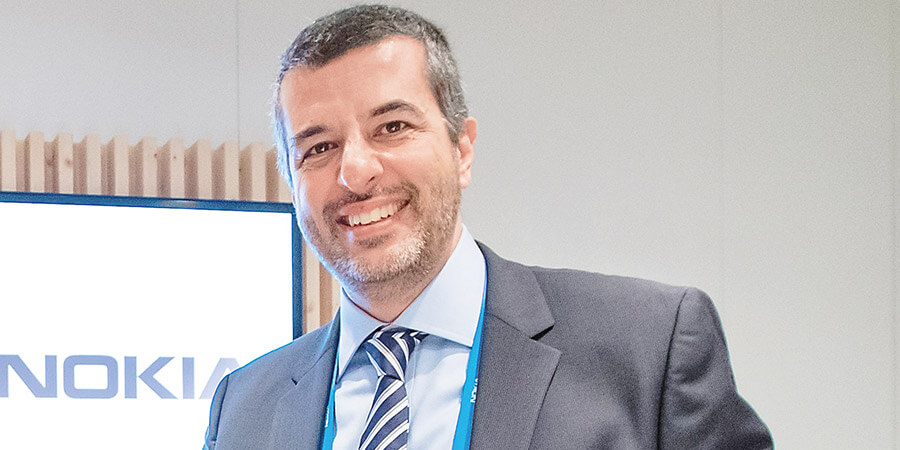Ahead of Telecom Review Summit, Roger Ghorayeb, customer team head for growth in West MEA, Nokia talked to Telecom Review about how Nokia's leading portfolio helps operators in their journey towards 5G deployment.
Nokia is a clear leader in 5G and it was evident from new 5G solution launches in the recent Mobile World Congress. How is your company helping operators to transform their networks and prepare for 5G deployment in Lebanon?
Let me first highlight that 5G is more than a new technology advancement unlike 3G and 4G. As such, 5G characteristics in terms of speed, capacity and latency rely on an exhaustive set of enabling technologies like, but not limited to, fiber backhauling, network slicing, automation and analytics as well as seamless IP infrastructure. Therefore, Nokia's 5G leadership position is based on its unique end-to-end portfolio offering.
Our end-to-end 5G offering includes Nokia's recently launched Future X portfolio and ReefShark chipsets, which allow operators to jointly program and tailor machine learning and automation. The Future X architecture invented by our Nokia Bell Labs research has made it possible to mix the knowledge across Nokia, between IP, optics, RF, software and innovative in-house silicon. We now expect to be able to deliver unprecedented capabilities and efficiencies that will allow our customers to transform their service offering for 5G.
While the industry is moving faster to 5G standard finalization, Nokia is accompanying its partners through a clearly defined evolutionary path - 4.5G Pro, 4.9G reaching ultimately 5G - with its commercially available 5G end-to-end portfolio. We initiated this engagement last year with Alfa where we demonstrated the 4.5G Pro reaching 1 Gbps throughput. We also completed the fiber transport project with MoT as well as the intelligent and software defined IP national backbone that is currently being installed across the 30 main central offices in different regions of the country enabled by Nokia's iconic 7750 SR routers family. These backbones will also benefit the mobile operators for increasing their own backbone capacities and capabilities.
Recently, Nokia was awarded part of the fiber infrastructure implementation that will enhance the fixed broadband services and the backhauling capabilities of the future 5G infrastructure. From the radio access side, the needed processing capacity and MIMO is gradually availed through Nokia's AirScale base-band unit that is currently being deployed in Alfa's mobile network.
Nokia partnered recently with Alfa to deploy Nokia's AirScale solution. Can you give us more details about this partnership?
Nokia is introducing its 5G-ready AirScale in 200 sites to Alfa's network. AirScale will provide the required processing capacity and will pave the way toward 5G. Nokia's 5G-ready AirScale basestations will be deployed in Lebanon for the first time, and will help Alfa to launch VoLTE services and improve the network coverage. It will allow Alfa's subscribers enjoy better quality of voice and experience ultra-broadband services.
In addition, the two companies signed a Memorandum of Understanding (MoU) at Mobile World Congress (MWC) to further evolve Alfa's network by applying the same Nokia AirScale system across 3G, 4G and 5G radio technologies, including CAT16 use cases. The MoU also aims to leverage internet of things (IoT), small cells and automation solutions, as well as Nokia's latest network optimization services, innovations and analytical tools to pave the way for next generation mobile broadband services which Alfa will pioneer in Lebanon.
In your opinion, what are the main challenges in Lebanon in the path toward the next generation networks?
The aspect of investment in the telecommunication infrastructure was historically an interesting point of discussion in the evolution toward the next generation networks. Fortunately, since last year, the MoT has started a series of enabling projects in this regard, and I mentioned some of these projects above.
The spectrum is another key requirement. It is a priceless asset that will require further regulations. With better management and regulation of this asset, many technologies and consequently network services can be offered (TV over LTE, for instance). Last but not least, further collaboration between public and private sectors within the ICT industry can help maximize the use of the existing hard or soft resources, and define use cases to expand the upcoming network evolution and services across all regions and cities in Lebanon.










